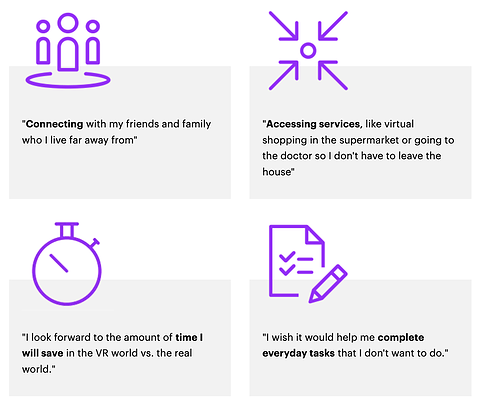Although the infrastructure of the metaverse is still being established, companies and brands are taking the leap into this new world.
We’ve seen many changes in our society over the last few years, but nothing holds the potential for change quite like the metaverse.
In 2021, when Mark Zuckerburg announced Facebook’s new parent company, “Meta,” the conversation of future societal implications of such an immersive social platform took the world by storm.
And for good reason.
Virtual reality (VR), augmented reality (AR), smart glasses, social media, and cryptocurrency have existed as separate yet related ideas until now.
The metaverse combines these moving parts to create a powerful tool for businesses and marketers alike.
Normal physical boundaries do not limit this world; therein lies its appeal for those looking for a more global reach.
How has the concept of the metaverse evolved, and where is it going?
Let’s find out.
How Virtual Reality Got Its Start With Online Gaming
The concept of virtual reality and augmented reality has been steadily leaked into mainstream culture over the last 20 years. The gaming industry was the first to take advantage of it and integrate it into different platforms.
Games like Pokémon Go (2016) and Fortnite (2017) revolve around using these technologies to connect people through their apps.
Pokémon Go is one of the largest, most successful augmented reality games in the industry.
When its popularity exploded in 2016, it heralded a new era of augmented reality’s integration into our everyday lives. AR integrates the digital and physical worlds into one.
Fortnite, a virtual reality game using avatars to represent players, lets people fight against each other in real time and attend events held in that particular metaverse.
These two highly popularized games helped introduce society to the concept of “extended reality” (XR).
Extended or mixed reality refers to all events that combine some element of what is real with what is virtual. This includes augmented reality and virtual reality forms.
XR creates a more immersive experience for users and blurs the boundaries between reality and what is generated by technology.
This blend of realities creates infinite possibilities for integrating different technologies to create a more holistic and immersive user experience.
Is The Average Consumer Ready For The Metaverse?
The metaverse will push marketing and most of society deeper into digital innovation and immersion.
But are consumers ready? Early adopters have been excited to use the new technologies, but what about regular consumers?
According to a survey of approximately 9,000 consumers around the world conducted by Accenture in late 2022, more than 70% of consumers intend to use the metaverse in non-gaming environments in the next two to five years.
However, what consumers want from the metaverse in gaming and non-gaming environments could be very different. According to the survey, non-gaming users focus less on the technologies and more on what they can get out of them.
In other words, consumers will come to the metaverse when they can get value for their “real” lives, such as helping them connect with friends and family, shop, and finish certain tasks in less time.
Regular consumers look at the metaverse as a new way to help them do what they’ve always wanted or needed to do.
 Image from Accenture, March 2023
Image from Accenture, March 2023The Metaverse Is Closer Than Ever Before – In Fact, It’s Already Here
According to a report from McKinsey & Company, the metaverse could generate $5 trillion in revenue for businesses by 2030.
Even though the metaverse is still in its early stages, there are plenty of opportunities to seize today.
Metaverse-native companies, such as CryptoMotors, make money from building and selling digital assets for the metaverse.
Traditional companies are also increasingly leveraging the metaverse to add value for their customers.
Real estate developer ONE Sotheby’s has a project called Meta Residence One, which builds a house along with its digital replica and sells both the digital house and the physical house together.
The owner of the twin houses will be able to greet guests in both the real world and the metaverse.
Even if metaverse commerce may not be a good fit for your business, the potential of using the metaverse as an advertising and marketing channel is endless.
As average consumers are looking for value and enhanced experience from the metaverse, it’s important for marketers to think beyond the technologies, and instead focus on how to better fulfill the customers’ needs in this virtual world.
How ChatGPT Will Affect The Metaverse
While the news about the metaverse has been overshadowed recently by generative artificial intelligence, most notably ChatGPT from OpenAI, the development and adoption of the metaverse are marching on.
In fact, the rise of ChatGPT will help make the metaverse an even more vibrant place.
Having non-player characters, or NPCs, in a digital game is not new.
However, NPCs, so far, lack the “intelligence” to interact with human players in an open and unscripted way. AI technologies, such as GPT-4, which powers ChatGPT, will change that.
To get a glimpse of what this interaction between human characters and computer-generated characters will look like, head toward Character.ai, where you can create virtual characters with “personalities” or simply chat with them in both one-to-one or group settings.
Now, imagine those characters as avatars in the metaverse, with faces and voices. Not only can they talk, but they also act and behave in ways that reflect their unique “personalities.”
For example, Replika, an AI-companion app, already allows people to build their own chatbots, dress them up in clothing and accessories from the Replika store, and enjoy the company of their chatbots in their own bedrooms through augmented reality.
What To Expect From The Metaverse Next
Moving forward, you can expect more metaverse-ready hardware to come to everyday consumers. Apple has already invested in augmented reality, and its virtual reality headsets, a.k.a. Apple Glasses, could be coming later this year.
Other tech giants, like Meta, Google, and Amazon, are also working on products to offer more immersive experiences for consumers.
On the business front, brands like Burberry and Gucci already advertise and sell virtual goods using AR and VR. Restaurant chains like McDonald’s and Panera Breads have already filed trademark applications for their businesses in the metaverse.
We’ll see more companies testing new ideas in the metaverse to better engage and serve their customers.
A new trend that will start to emerge is the corporate metaverse, where companies use the metaverse to train and empower their employees, allowing them to collaborate with each other more effectively from anywhere in the world.
Marketers should pay particular attention to the evolution and progression of the metaverse.
Those who are skeptical might miss out on a significant amount of digital innovation set to change the way society does business and functions as a whole.
More Resources:
- Effective Brand Building In The Metaverse
- A Marketer’s Guide To NFTs And The Metaverse
- Marketing In The Metaverse [Podcast]
Featured Image: Black Salmon/Shutterstock





